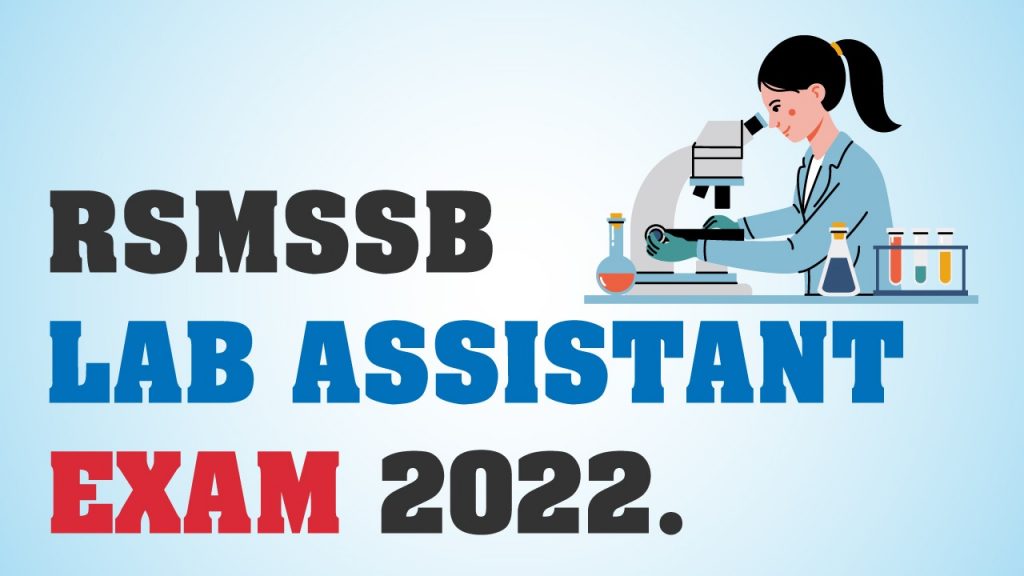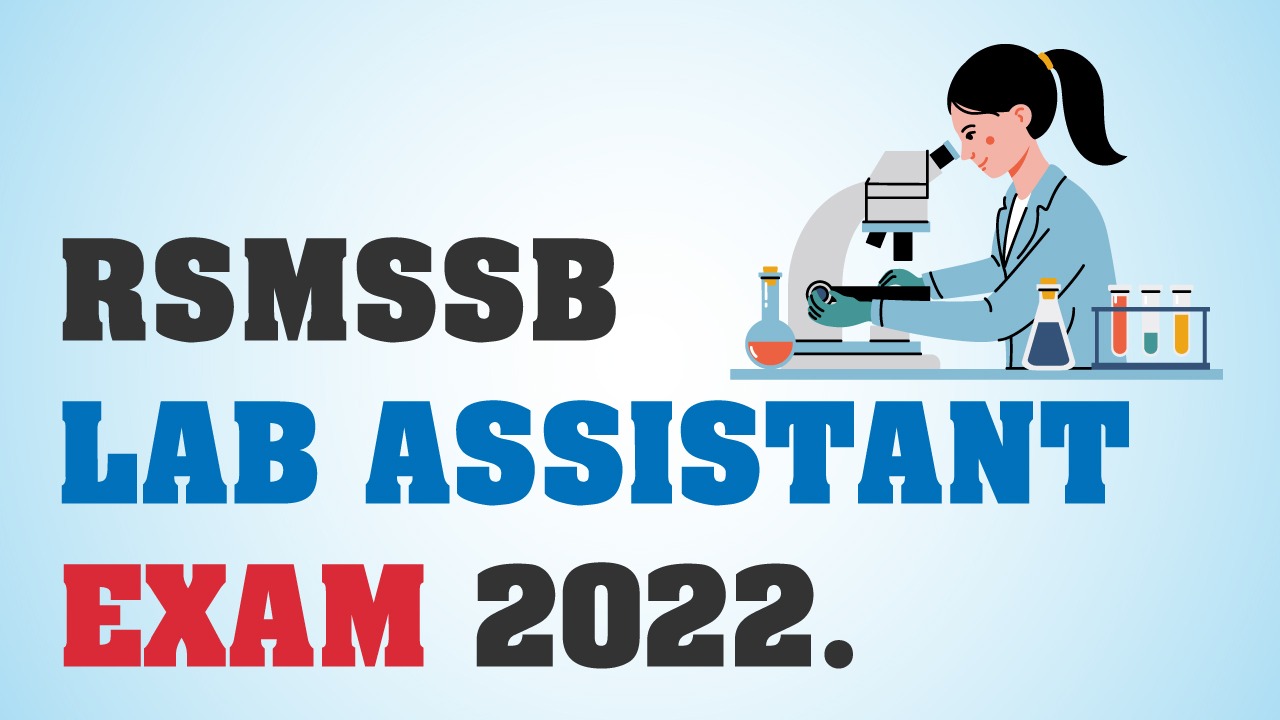The Rajasthan Subordinate and Ministerial Services Selection Board (RSMSSB) holds numerous annual hiring events for employment as RSMSSB Lab Assistants. This article will discuss detailed information about the Rajasthan Lab Assistant exam 2022, like Exam Date, Latest Syllabus, Exam Pattern, Admit Card, etc.
The candidates will be chosen based on their performance on a written test. With lots of vacancies, they are among the most searched exams. One of these tests is for lab assistants with the RSMSSB.

The RSMSSB Lab Assistant paper is divided into three sections, and the exam lasts three hours. Both the application process and the evaluation are done online. For the role of RSMSSB Lab Assistant, applicants must be between the ages of 18 and 40. Candidates must start their exam preparations early if they hope to pass the RSMSSB Lab Assistant exam with a high grade.
Lab Assistant 2022 Highlights
The table below lists some of the major key pillars of the RSMSSB Lab Assistant Recruitment Exam 2022:
| Particulars | Details |
|---|---|
| Test Name | Rajasthan Subordinate and Ministerial Services Selection Board Lab Technician Recruitment test |
| Leading Body | Rajasthan Subordinate and Ministerial Services Selection Board (RSMSSB) |
| Name of the department | Rajasthan Medical, Health, and Family Welfare office |
| Level of Exam | State Level Examination |
| Method of Examination | Offline |
| Length of Exam | 180 minutes (3 hours) |
| Number of Questions | 150 questions |
| Test type | Multiple Choice Questions (MCQs) |
| Negative Marking | 0.33 i.e. 1/3rd of total |
| Exam Dates | 28th & 29th June 2022 |
| Job Location | Rajasthan |
| Maximum marks | 300 |
| Frequency of the exam | Annually |
| Official Website | https://rsmssb.rajasthan.gov.in/ |
Lab Assistant Eligibility Criteria
Below are the criteria for these positions in terms of education:
- Candidates must have completed the 12th grade from an authorized board with Physics, Chemistry, Maths (PCM) or Physics, Chemistry, and Biology (PCB) as their core subjects to apply for the exam.
- Candidates must hold a medical lab technician endorsement from a body recognized by the federal, state, or Rajasthan Paramedical Council to apply for the exam.
- Candidates who apply for the exam should be proficient in Hindi, written in Devanagari script, and well-versed in Rajasthani culture and way of life.
Lab Assistant: Age Limit
According to RSMSSB regulations, aspirants for the lab assistant position must be within the age group 18 and 40 as of January 1, 2022. They are listed in the following table:
| Category | Age Limit Relaxation ( in years) |
|---|---|
| SC/ST/OBC/EWS (male) (for Rajasthan) | 5 |
| SC/ST/OBC/EWS (female) (for Rajasthan) | 10 |
| General (female) | 5 |
| Person With Disability (General) | 10 |
| Person With Disability (OBC) | 13 |
| Person With Disability (SC/ST) | 15 |
How to apply for the RSMSSB Lab Assistant Application Form 2022?
- Go to the official Rsmssb.rajasthan.gov.in website and click on the Lab Assistant link.
- Click on Apply to access the Lab Assistant online application form, the most recent 2022 job notifications, and the PDF notification.
- Before the deadline, submit your basic information (education and contact information) for the Rajasthan Lab assistant position for 2022.
- Apply for a position as a lab assistant by paying the application cost online or offline.
- Upload your documents, and finalize and confirm your application.
Lab Assistant Exam Pattern 2022
The exam format is the most important thing for each candidate to understand before beginning their study. We have given the RSMSSB Lab Assistant exam 2022 in point-by-point form here for the benefit of candidates.
- There will be two sections – General Knowledge & General Science.
- There will be a negative marking of 0.33 marks.
| S.No. | Sections | Total Question | Total Marks | Time Duration |
|---|---|---|---|---|
| 1. | Geographical, historical, cultural, and General Knowledge. Current Affairs of Rajasthan General Knowledge of the World and India Educational Psychology | 100 | 200 | 2 Hours |
| 2. | General Science at the secondary level (Physics, Chemistry, Biology) | 100 | 200 | 2 Hours |
| Total | 200 | 400 |
RSMSSB Lab Assistant Syllabus 2022
To proceed to the next stage of the hiring process, candidates must pass the Lab Assistant Exam 2022. There are two sections to the syllabus. General Knowledge makes up the first section, and General Science makes up the second. Each section’s questions will all be of the objective kind.
Paper I
Geographical, historical, cultural, and General Knowledge
- Major sources of the history of Rajasthan
- Major Civilizations of Rajasthan
- Major dynasties of Rajasthan are their achievements
- Mughal Rajput Relations
- Salient Features of Architecture
- Important Fort Monuments and Compositions
- Religious Movements and Folk Goddesses of Rajasthan
- Major Painting Styles and Handicrafts of Rajasthan
- Major works of Rajasthani language and literature and regional dialects
- Fair Festivals Folk Music Folk Dance Instruments & Jewelry
- Rajasthani Culture Tradition and Heritage
- Important Historical Tourist Places
- Prominent Personalities of Rajasthan
- The Princely States of Rajasthan and British Treaty, 1857 People’s Movement
- Kathak and tribal movement, Prajamandal movement
- Unification of Rajasthan
- Political awakening and development of Rajasthan with special reference to women
Rajasthan Geography
- Position and extent
- Main physical division – desert region, Aravalli hill region, plain region, plateau region,
- Drainage System
- Climate
- Soil
- Natural Vegetation
- Forest and Wildlife Conservation
- Environment and Ecosystem
- Desertification
- Agro-climatic region and major crops,
- Livestock
- Multipurpose Project
- Irrigation Projects
- Water Conservation
- Transport
- Mineral wealth
Current Affairs of Rajasthan
General Knowledge of the World and India
Educational Psychology
Paper-II
Biology
Part A
- General characters of Algae, Fungi, Biophyte, Pteridophyta, Gymnosperms, and Angiosperms.
- Morphology of angiosperm – structure, and transformation of the root, column, and whole. Structure of flower and seed.
- Plant Anatomy- Tissue and Tissue System. Secondary growth.
- Plant Physiology: Transmission, water absorption, transpiration, photosynthesis, respiration, plant growth, and movements.
- Environmental Studies- Structure and Types of Ecosystem Energy Flow Biogeochemical Cycle Ecological Adaptation, Environmental Pollution, Biodiversity, population ecology.
- Biotechnology- General knowledge, Regenerative DNA technology, Transgenic plant and animal ethical issues, Application of biotechnology in agriculture and medical field.
- Economic importance of plants.
- Cell Structure – Cell Theory and Cell Division.
Part B
- Genetics: Mendel’s law, general terminology, the structure of DNA and RNA, molecular origin of heredity, the structure of chromosomes, sex determination, and genetic disorders in man.
- Classification of the animal kingdom: Classification of invertebrates up to the phylum and vertebrates.
- Digestion, respiration, and excretion in humans, proteins, sugars, fats, vitamins and digestive enzymes, exchange of gases, oxy and non-oxygen respiration, Kreb cycle, glycolysis, excretory substances, structure and function of the kidney.
- Circulatory and Endocrine System of Human: Structure of the Heart, Composition of Blood, Blood Groups, Blood Clotting, Lymphatic Glands, Antigens and Antibodies, Endocrine Glands and their Hormones.
- The nervous system of humans: Structure of brain, eye, and ear, the structure of a neuron, nerve impulses.
- Muscular System: Types of muscles and muscular contraction.
- Human and reproductive system in human diseases: structure and reproductive health, diseases caused by bacteria, viruses, protozoa, fungi, and helminths.
- Biological evolution, the economic importance of animals.
Physics
- Dynamics of Rigid Body – Torque, Conservation of Angular Momentum, Moment of Inertia of Simple Geometric Objects.
- Thermodynamics: First and second law of thermodynamics, heat engines, and refrigerators.
- Oscillatory: simple harmonic motion and its examples, resonance.
- Waves- Doppler effect, the principle of superposition of waves.
- Static electricity – Coulomb’s law, Electric field, Gauss’s theorem, and applications.
- Electric current-Kirkoff’s law Stone, Wheatstone bridge, meter Bridge potentiometer.
- Optics-Microscope and Telescope, Interference, Diffraction, and Polarization, Polarimeter.
- Atomic – Bohr model of the hydrogen atom.
Nuclei – Mass defect, nuclear binding energy, fission, and fusion. - Semiconductor electronics- Zener diode, pn junction, transistor, logic gate, diode as a rectifier.
Chemistry
Unit I- Periodic Table and Atomic Properties
- Fundamental particles of an atom (electrons, protons, neutrons)
- Rutherford’s nuclear model
- Quantum number
- Pauli’s exclusion principle
- Aufbau principle
- Types of orbitals ( s,p,d,f ), the shape of orbitals
- Hund’s rule
- Modern periodic table
- Variation in atomic properties (size, ionization potential, electron affinity, electronegativity)
Unit II- s-block and p-block elements
- General introduction
- Electronic configuration
- Occurrence
- Oxidation state
- Trends in physical and chemical properties
- Inert pair effect
Unit III- Chemical Equilibrium
- Factors affecting equilibrium
- Reversible and irreversible reactions
- Laws of chemical equilibrium
- Lee-Chatelier’s theory
Unit IV- Ionic Equilibrium
- Acid-base equilibrium
- pH value
- Common ion effect
- Buffer solution
- Acid-base titration
Unit V- Gaseous State
- Properties
- Boyle’s law
- Charles’ law
- Avogadro’s law
- Dalton’s law
- Ideal gas equation
- Graham’s law of diffusion
- Kinetic theory of gases
Unit VI- liquid state
- Properties of liquids
- Vapour pressure
- Solid state
- Surface tension
- Viscosity
Unit VII – Properties of solids
- Properties of solids
- Unit cells and their types
- Packaging of crystal
- Structure of Simple Ionic Compounds
- Defects in crystals (Fenkel, Schottky)
Unit VIII- Solutions
- Solute, solvent, and solution
- The concentration of solution (molarity, normality, formality, molality, mole fractional mass percentage)
- Types of Solutions (Gaseous Solution, Liquid Solution, Solid Solution)
- Raoult’s law
- Ideal and non-ideal solutions
- Colligative properties of a solution
Unit IX- Nomenclature and general properties of organic compounds
- Rules of IUPAC nomenclature
- Types of reactions (substitution, addition, elimination)
- Electrophiles, Nucleophiles
- Inductive effect, Electromeric effects
- Resonance, hyperconjugation steric effect
- Isomerism (structural the stereoscopic)
Unit X- Hydrocarbons
- Definition and Types of Hydrocarbons (Alkenes, Alkynes, Alkynes, Arene)
- Preparation of hydrocarbons
- Physical properties
- Chemical properties
Most students rush to tutoring and coaching as soon as the tests and curriculum are revealed. And if you’re looking for the same thing, you need to visit DHURINA. Experts Subhash Charan Sir & Team at DHURINA are always available to assist and advise you in achieving the highest score.
All the best to all the students for upcoming exams !!!



